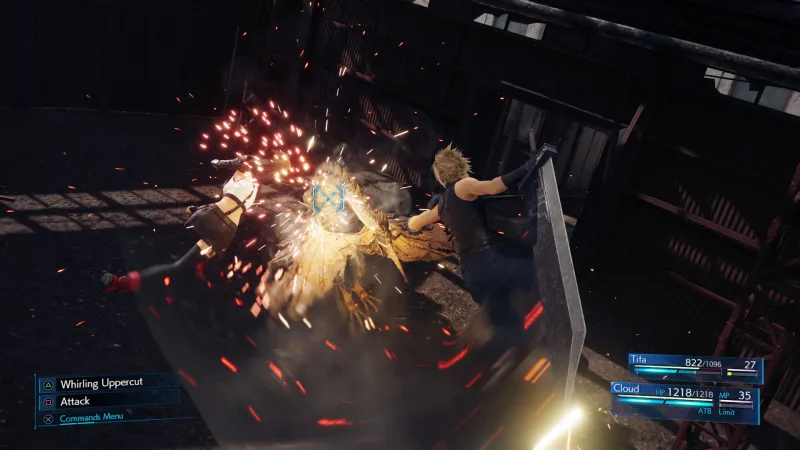


From its original announcement at E3 2015 to its release last month, Final Fantasy VII Remake was the focus of intense excitement and anticipation. Though fan expectations for the project were extremely high, the team at Square Enix delivered. Final Fantasy VII Remake delighted players by delivering an RPG that paid homage to its classic roots while adding plenty of modern twists. So how did they do it? How did the team accomplish the seemingly impossible feat of satisfying old fans while bringing in new ones? And what was up with that ending? We got some answers to these questions and more from two key figures on the Final Fantasy VII Remake development team: producer Yoshinori Kitase and co-director Naoki Hamaguchi.
How did you decide which parts of the original game would get new or expanded content in the remake?
Hamaguchi: The decision about which parts of the original game would be carried forward into Final Fantasy VII Remake was largely entrusted to the creativity of the game designers responsible for in-game locations. The direction we gave to the game designers was: “When designing the game, always expand upon elements of the original.” Due in part to the fact that this is a remake of Final Fantasy VII, most of the members of the development team had been fans of the original. I think we could say that each of them had their own personal thoughts and perceptions when it came to Final Fantasy VII, and they drew on that to shape this title. For example, we hadn’t originally planned to include the squats in Wall Market, but the on-site game creators were passionate about it, saying, “We need to have this because it’s definitely going to be something that players are looking forward to,” and that’s how it came to be a reality.
Also, sometimes we’re asked the question, “Since this is a remake, was individual creativity not sought after as much as the original?” But in fact, that was not the case. We needed to think about which elements to reimagine, and how to portray them in a form of modern entertainment. As such, we were able to create a different experience from the original Final Fantasy title.
What was the biggest debate you had among the team during development?
Kitase: We didn’t run into any particularly big debates. From the very beginning, the team approached development based on a philosophy of “respecting the original,” so we never encountered any major disconnects.

How much did you experiment with different versions of the combat system? What do you like best about the combat mechanics that were eventually implemented in Final Fantasy VII Remake?
Hamaguchi: The concept of Final Fantasy VII Remake’s battle system was clear from its early stages, which was that we wanted to take the original game’s Active Time Battle (ATB) system and portray a modern-day evolution of it. In order to achieve more immersive gameplay with higher-quality graphics, we felt that we would need real-time controls. To this end, we went down the road of evolving the ATB system to be more action-oriented.
Trial and error ensued, and it wasn’t until about a year prior to having the finished build that we fully solidified the battle system. We didn’t want to simply fuse together the “ATB system” with “action battle.” Instead, we wanted to use the rules of the original game’s ATB system, with an ATB gauge that could be consumed to trigger abilities, while also incorporating action-battle system elements. These elements included enabling the player to be more efficient in filling up their ATB gauge, and creating ideal moments to use their abilities to consume ATB. Our days were filled with explorations of how action-battle elements could add to the ATB system based on each player’s technique.
My favorite part of this game’s battle system is how customizable it is for players. The Materia system from the original game had amazing customizability. However, at the same time, it allowed every character to be customized in a similar fashion. As such, this ability to enhance characters in any way also made it more difficult for each character’s unique aspects to be captured. Therefore, in Final Fantasy VII Remake, we really wanted to ensure that each character’s unique qualities were retained while also marrying this with the high degree of customization that the Materia system offered. To achieve this, we gave the characters their own unique abilities, instilling in each a distinctive feel and strategy through the battle system. By combining that with the customizability of the Materia system through commands, I think we were able to create a depth that might surpass even that of the original battle system.
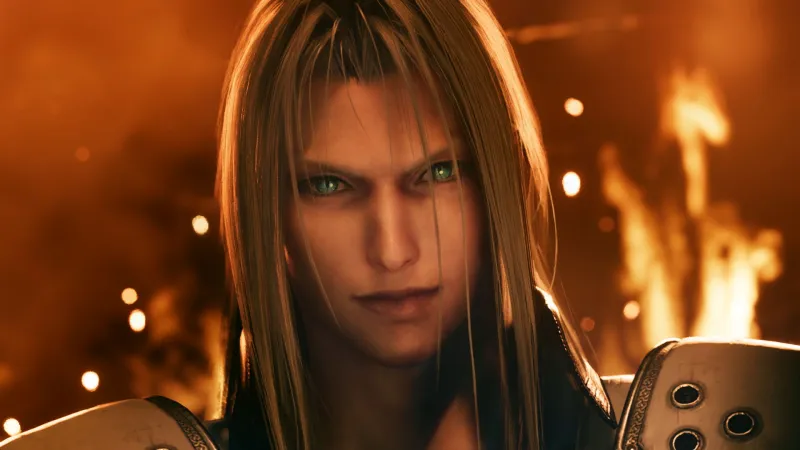
Sephiroth plays a role much earlier in this new version of the story. Were you worried that introducing him so soon would make his actions later less menacing?
Kitase: The original story was in the form of a mystery, and of course back then, nobody knew going in about what was to come. The production reflected this, with the conscious decision to avoid showing the looming threat that is Sephiroth until the latter half of the story, thereby heightening the feeling of dread in a fashion, similar to the movie Jaws.
This time, however, we knew that many fans were already familiar with Sephiroth. Therefore, we determined that taking the same approach in production wouldn’t be fitting. Instead, in Final Fantasy VII Remake, we wanted to make it clear that his presence is one that dominates throughout the series as a foil directly in opposition to the main character, and that led to us taking this approach.
Can you give an example of something that you wanted to include in the remake but couldn’t fit in?
Hamaguchi: This might be very specific, but here goes… Many of the minigames in FFVII Remake pay homage to the source material, but there was one minigame that we wanted to pay homage to and implement, but could not, and only a trace of it remains (laughs).
Do you remember there was a basketball mini game in the Gold Saucer from the original game? Well, we had prepared a basketball hoop on the way to Jessie’s parents’ home in Sector 7, but I decided it would not be very fitting at all to have a minigame where you hear the sounds of a basketball echoing through the quiet hours of the night. That being said, we did want to pay some kind of tribute, so you see just a basketball left there, and it just rolls around.
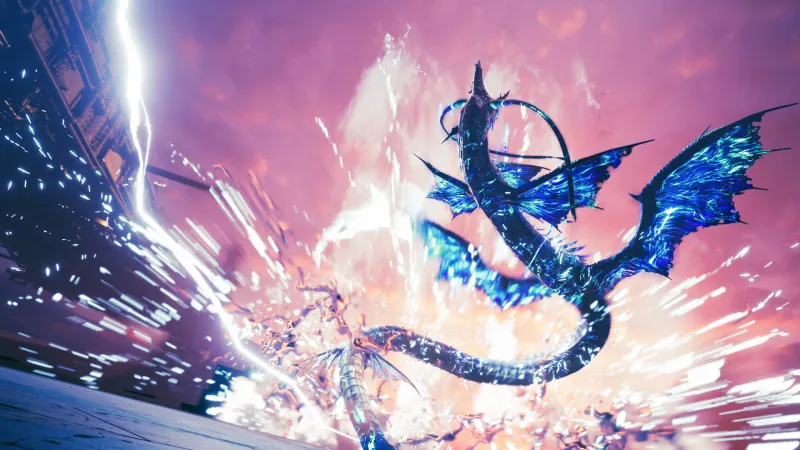
The summons in Final Fantasy VII Remake are cool, but they can’t be used in every battle. Why was it important to limit players’ access to them?
Hamaguchi: Coolness is a trait that people look for in the summons that appear in Final Fantasy, so I’m glad if you felt that way (laughs). Let’s see, there’s actually a clear reasoning behind our decision to prevent players from being able to use them freely in any and all battles, which was how it was in the original. This isn’t limited to summons, but whenever there’s a mechanic that can be used at any time, we have to ensure that the battle system has been properly designed to incorporate pros and cons that accompany its usage. Otherwise, that mechanic can become a sure-fire method for victory every time, and battles could end up becoming a repetitive and monotonous task.
When we incorporated summons into the battle design, we also prioritized creating an experience that felt particularly exciting and special. Rather than incorporating summons as a strategic element to be used at any time during battle, we thought that it would feel more memorable and exhilarating if they could be experienced as a so-called “fever time,” where a summon would stay and help the player during the entire time it was there. Based on this decision, we narrowed down the conditions required for summoning while also reducing the MP consumption to zero. As a result, I think we were able to incorporate summons into the battle system in a well-balanced manner.
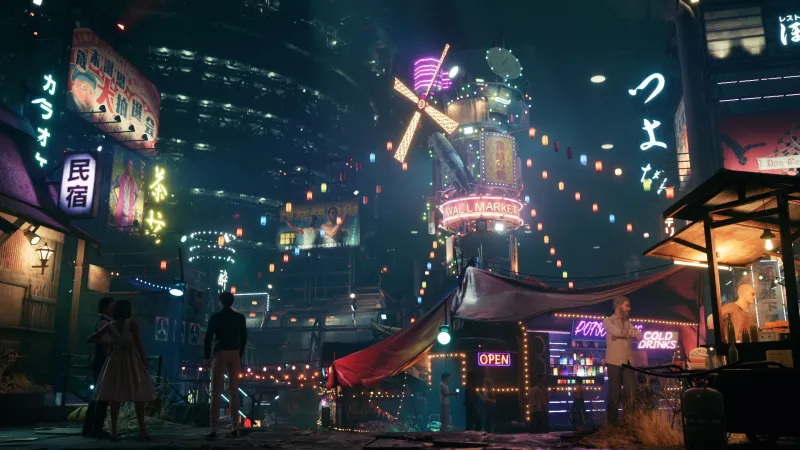
The reimagined version of Wall Market is one of the highlights of Final Fantasy VII Remake. What did you see as the essence of this area that you wanted to convey to players?
Hamaguchi: Just like the original title, I believe the essence of Wall Market is its depiction as an entertainment district for grown-ups. That being said, there is a clear difference in how we presented these elements, to be suitable for the modern era.
With that in mind, we tried to look into how we could showcase this area as an entertainment district suitable for people from a wide range of cultures and age, while also dialing back on the “adult” aspect of it. We decided we wanted to make the Honeybee Inn a dazzling dance production in the vein of Moulin Rouge, the Corneo Coliseum an exciting underground battle arena that grown-ups could go crazy, and Madam M’s massage parlor would have a tantalizing, alluring aspect; and that’s how we arrived at the reimagined Wall Market. Of course, we made sure to incorporate the fundamental essence of the original Wall Market, so I believe we were able to make it a familiar yet new area, rather than it being a complete departure from the source material.
Many players were nervous about how the scenes with Cloud at the Honeybee Inn would be handled, but the remake pulls them off well. What was the hardest part of adapting that sequence?
Hamaguchi: We had already determined that Wall Market as a whole, including the Honeybee Inn, would be updated significantly from the original game, and this was an area co-director Motomu Toriyama put so much of his heart and soul into. I think that passion also came from the fact that Mr. Toriyama himself was the person handling the Wall Market in the original game, too (laughs).
“If we’re going to change it, we might as well make it highly entertaining” – that was the directive, and so we referenced things like the French Moulin Rouge and Japanese burlesques, so that the Honeybee Inn would include this dance battle to show each other up. With these references in mind, we were given the animations for Cloud and Andrea’s dance sequence and were tasked with incorporating that into the game … It was such a dynamic dance scene, so rather than muddling the screen with two-dimensional UI elements, we went with a three-dimensional UI that is integrated into the sequence; we worked really hard to prioritize the integration of the dance scene with this integrated UI.
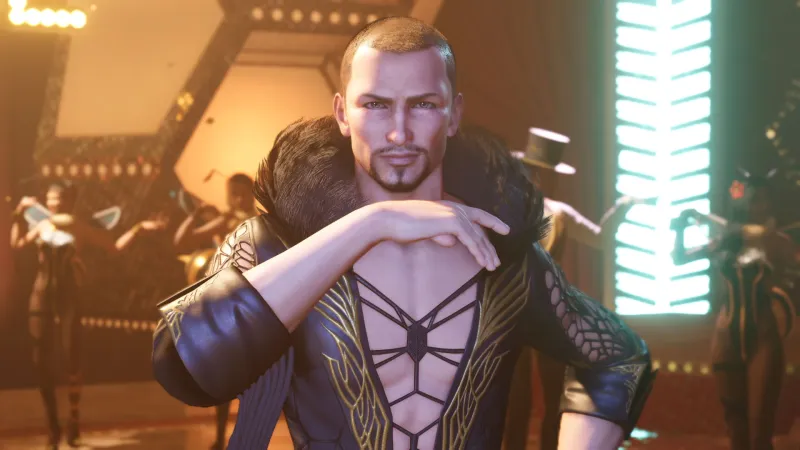
How did you arrive at the choice to implement a chapter-select option for post-game play, rather than just a regular new game plus?
Hamaguchi: I think this may be the first Final Fantasy title in which you can select chapters after you’ve finished the game. In fact, this was something I wanted to implement in FFVII Remake from early on, so I went to propose the system to Tetsuya Nomura. The reason was very clear: There are memorable scenes from the original title that are recreated as photorealistic cutscenes, and I wanted to make it so there would be easy access to them whenever the player wants to view them again. Also, for instances where there are variations of cutscenes, we made it convenient so that the players can select the scene they want to go to, and play only the parts that are required to trigger each cutscene without having to go back and redo everything from scratch.
Before joining the FFVII Remake development team in earnest, I was on the development team for a smartphone game called Mobius Final Fantasy; due to the nature of smartphone games, I had to be cognizant of the convenience of gameplay – a sort of “whenever, wherever” mentality – so, perhaps we can say I drew inspiration from my experiences in developing for smartphone games.
The final chapter implies that the story will now start branching out in significantly different directions compared to the original Final Fantasy VII. Without spoiling too much about the ending, is that an accurate interpretation of those events?
Kitase: My providing any sort of answer here will take away the fun from what is going to come, so I will have to refrain from saying anything.
Right now, fans around the world are thinking about various theories. That is exactly what I was hoping people would do. I would encourage everyone to stretch their imagination as you wait, until we are able to bring you the next installment.
For more on Final Fantasy VII Remake, you can watch the video review, see the game in action on New Gameplay Today, and read about why it's a complete game – despite being the first part of a larger story.

Explore your favorite games in premium print format, delivered to your door.